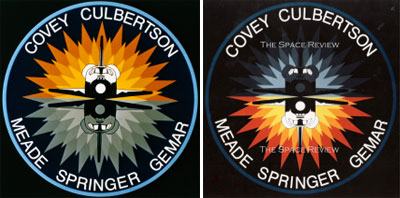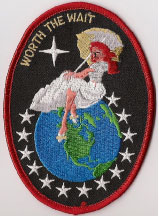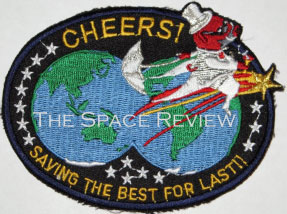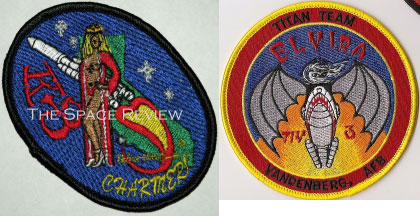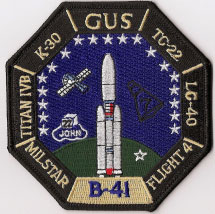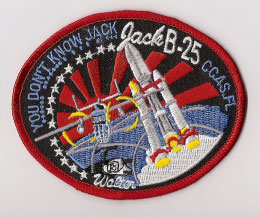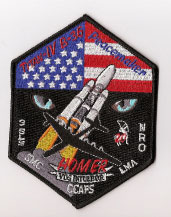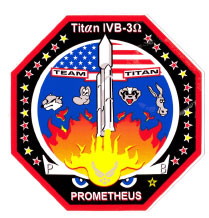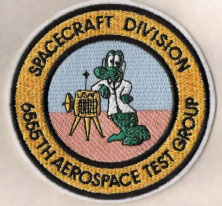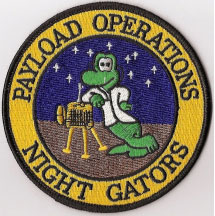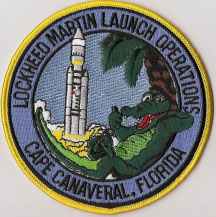Space Age hieroglyphsThe pretty girl and the flying pigNot all high altitude signals intelligence satellites used the dragon motif. In particular, two satellites did not, but contain many intriguing symbols of their own. The first was the June 24, 1996, launch of Titan IV (mission K-16), nicknamed “Sweet 16” on its rocket patch. Observers speculated that this was a signals intelligence satellite of a different type from the “Trumpet” and “Advanced Orion” types. Instead of an 86-foot long launch shroud, this rocket had a 23.2-meter-long (76-foot-long) shroud and the payload was reportedly called “Mercury”. The mission patch for this launch featured a pretty girl sitting atop the world, a reference to a girl’s Sweet 16 party (Figure 10). The girl was holding a gold parasol; again, an obvious reference to a dish antenna. The patch also featured fourteen stars, and it turns out that this K-16 launch was the fourteenth launch of this type of payload.
On August 12, 1998, the Air Force launched another Titan IV (mission A-20) with similar characteristics to the June 1996 K-16 Mercury launch. Instead of a pretty girl, the payload patch for this mission featured a flying pig, dressed in white like the girl, and carrying an umbrella like the girl (Figure 11). But it also featured fifteen stars—i.e. one more than the last launch—plus a gold star. Notably, whereas the earlier patch had only one globe, this featured two, possibly indicating a change in operations such as expanding the ground coverage of the satellite constellation. Finally, the patch included the phrase “saving the best for last,” a clear hint that this was the last payload of that type.
Titan IV nomenclatureIn addition to connecting the satellites to specific patches, we also received a wealth of information on several of the more information-laden Titan IV launch vehicle patches. As we noted in our earlier article, these are frequently filled with references to the military organizations involved with the launches, as well as inside jokes that those directly involved in the launch would recognize.
Sometimes the patches created some unwanted controversy within the military organizations involved with the launches. For a November 28, 1992 Titan IV launch (mission K-3) that reportedly carried a KH series reconnaissance satellite into orbit from Vandenberg Air Force Base, the launch team produced a patch (Figure 12) that featured a scantily-clad woman (obviously pre-dating current sexual harassment regulations!) standing in front of a Titan IV rocket and the word “Charmer” below (possibly a reference to this being the launch of vehicle K-3 and the phrase “third time’s the charm”). Reportedly, many of the professional women on the launch team were rightfully offended by the sexist nature of the patch, voicing objections that they had joined the Air Force or worked for a defense contractor to serve their country, not to be treated like sex objects. As a result, the distasteful “Charmer” patches were quickly recalled, replaced by a new “official” launch patch—“Elvira”—featuring a bat-like creature riding the Titan (Figure 13).
On February 27, 2001, a Titan IV Centaur rocket (mission B-41) launched the third Milstar communications satellite into orbit. There was nothing particularly noteworthy about the unclassified launch. The rocket patch (Figure 14), however, contained a lot of symbolism, starting with the name of the Titan launch vehicle, “Gus”. The mission was named after astronaut Gus Grissom, who commanded the first manned spaceflight to use a Titan rocket. The green at the bottom of the patch symbolizes the Earth and all the personnel that support the launch program, and the blue represents the sky. The black border represents space. The patch also contains the name John, a reference to Grissom’s co-pilot on his Gemini-Titan 3 mission, John Young. The nineteen stars did not represent the number of Titan launches. Instead, they represented Complex 19 where Gemini-Titan 3 was launched. The capsule with a seven inside referred to the Mercury 7 astronauts. The eight-sided patch referred to the eight hard mating points between Milstar and Centaur. One lone star at the bottom represented fallen heroes—like Grissom.
On May 8, 1998, the Air Force launched Titan IV mission B-25 from Cape Canaveral, carrying the second of the “Advanced Orion” signals intelligence spacecraft (the one represented by figure 4). The Titan was nicknamed “Jack”, after actor Jack Lemmon, as part of a theme for the payload and launch campaign. Lemmon was star of the movie The Odd Couple, and later the movies Grumpy Old Men and Grumpier Old Men—symbolism that the launch team felt typified government/contractor relations. But the name may also have been a double joke, as Lemmon’s surname was also rumored to signify the vehicle itself, which had experienced (and overcome) many difficulties—i.e., a lemon. The slogan on the launch vehicle patch (Figure 15)—“You don’t know Jack”—was also apparently intended as a double joke. It was both a defiant refutation of the “lemon” reputation, as well as a taunt to the rest of the world that had no idea what was on the rocket (i.e. the phrase “you don’t know Jack #@!%”).
The Titan vehicle patch represented each previous successful Titan IV launch at the Cape. Alluding to its mission designation—B-25—the patch prominently featured a World War II B-25 bomber; the five stars under its wing signified each of the five commanders of the Fifth Space Launch Squadron: Lt. Col. Bill Barnett, Lt. Col. Craig McAllister, Lt. Col. Larry James, Major Frank Arena, and Lt. Col. Ed Thomas. The patch also has some very subtle inside jokes as well. A chip missing from the bottom left of the right solid rocket motor was symbolic of the name “Chip” earned after the rocket suffered damage to a bracket which contacted a lifting sling. A lightning bolt at the top left solid rocket motor is symbolic of the name “Sparky” given to the other solid rocket motor after operators became concerned that electrostatic discharge had damaged the electronics and they were replaced. The setting sun was intended to be symbolic of an era as this was the last launch by the 5th Space Launch Squadron (5 SLS) and the rocket was also projected for an evening launch… into the sunset. Finally, the setting sun was also symbolic of Jimmy Doolittle’s successful B-25 raid on Tokyo which marked a turning point in the war in the Pacific. “Walter” was the launch crew’s name for the Centaur, TC-18 (symbolized by the melting ice cube just above it containing ‘18’). It was also the first name for Walter Matthau, who co-starred with Lemmon in The Odd Couple and the Grumpy/Grumpier Old Men movies. The black background was intended to symbolize the black world of the NRO and the red symbolized the classified nature of the payload. On September 9, 2003 the Air Force launched another Titan IV from the Cape, mission B-36. This was the same launch that was associated with one of the earlier noted “dragon” patches and reportedly carried the last of the “Advanced Orion” signals intelligence satellites (see Figure 5). The launch vehicle was named ‘Homer’, after LeRoy Homer, the first officer on United Airlines Flight 93, who died on September 11, 2001. Homer was a 1987 US Air Force Academy graduate and a major in the Air Force Reserves.
The mission patch (Figure 16) contained a lot of symbolism. As with B-25’s “Jack” and “Walter” patch, mission B-36 was symbolized on its patch by a B-36 Peacemaker bomber. There were 23 stars on the flag representing the previous 23 Titan IV missions launched from Cape Canaveral. The number 20 and the outline of a Centaur (half-man half-horse) referred to Titan-Centaur #20. The patch also contained the Latin phrase Vos Intuebor, which roughly translated means “I will be gazing upon you,” and the cat’s eyes also echoed this theme. Homer Simpson’s webpage revisitedAs we noted in our earlier article, occasionally the patch designers went overboard including various inside jokes and symbology, filling up a patch with so many icons and images that it became hopelessly cluttered—like Homer Simpson’s famous attempt at a website, which came complete with a dancing Jesus icon. The best example was the patch (Figure 17) created for the last East Coast Titan IV launch (mission B-30), which lifted off on April 30, 2005, reportedly carrying the last of a class of large radar satellites commonly referred to as “Lacrosse”. We speculated on the meaning of many of the symbols on the launch vehicle patch, but now have a definitive explanation in the form of a PowerPoint slide that the launch team developed to explain all of the things they had included in the patch.
The ultramarine blue circle background (Air Force Blue) had a two-fold meaning. The blue represented the Air Force, and the circle represented the Earth. The explanation was that “the two of them together remind us of our obligation to secure freedom through global vigilance, reach, and power.” The Omega symbol represented the fact that this was the last Titan IV to be launched from the Eastern Test Range. The red octagon also represented the stop sign which signifies the stoppage of the Titan program. The cat’s eyes represent the NRO’s mission of watching over the world. The fifteen stars represented the fifteen Titan launches undertaken by the Fifth Launch Squadron before it was disbanded. The ten yellow stars represented the number of Titan launches accomplished by the 3rd Space Launch Squadron (3 SLS) after it took over the mission from the 5 SLS.
The cartoon characters were from the comic strip Pogo, but were also symbols representing different members of the launch team, including the “Night Gators” who are responsible for moving the classified payloads to the pad under cover of darkness, and the “Booster Badger.” One of the other characters was “Max Muler,” and the last one is unidentified; both their meanings remain unclear. PB stood for Peter Boxer, representing the enlisted men and women and (apparently) one of the Titan Maintenance Controllers of the 3 SLS. Finally, Prometheus was one of the Titans. His name means Forethought. He is known as the protector and benefactor of man. He gave mankind a number of gifts including fire. Night GatorsThe cartoon characters on the Prometheus patch allude to another aspect of this secretive world. While space missions had patches, there are, of course, patches for the secretive organizations that support them, such as the Night Gators represented on the Prometheus patch. Three excellent examples are patches from the 6555th Aerospace Test Group (Figures 18 and 19) and from Lockheed Martin Launch Operations (Figure 20). One patch depicts a gator standing next to a small spacecraft. This patch was changed when Space Command took over the unit, resulting in the second patch with the word “Payload Operations Night Gators.” This refers to the fact that all payload hardware such as spacecraft and the ground support equipment is moved at night so that it avoids observation by other workers at the facility as well as spying satellites. The Lockheed Martin patch with the gator pointing toward the Titan indicates that they built the launch vehicle and were responsible for launch preparations as well as the Titan’s Cape Canaveral launch site.
Certainly we have only scratched the surface of this exclusive culture of those who launch and maintain the highly secretive hardware operated by the National Reconnaissance Office. There are undoubtedly more revelations to be found. Home |
|
